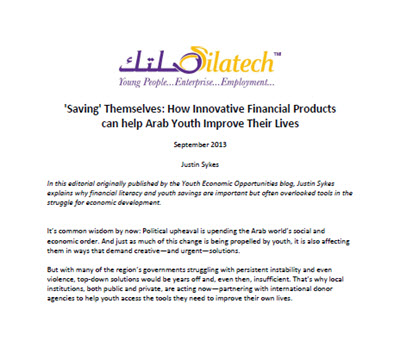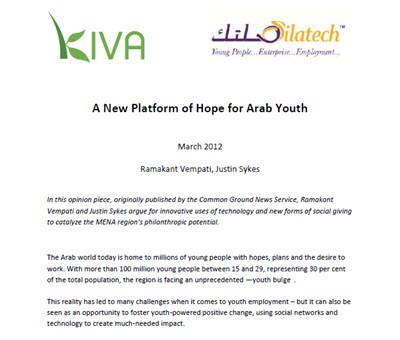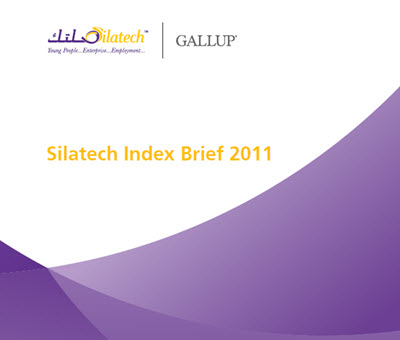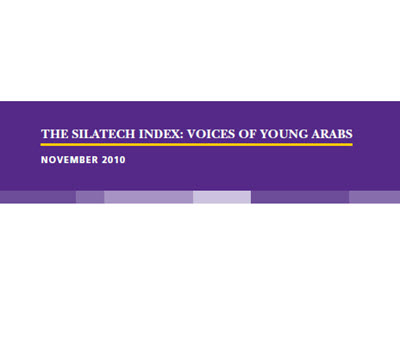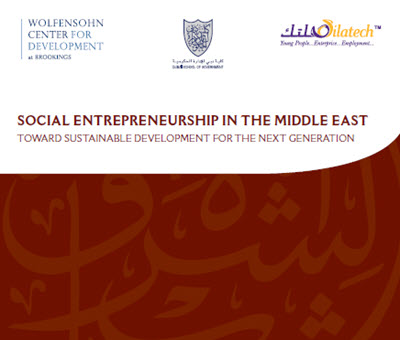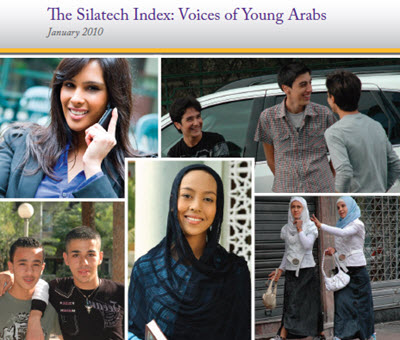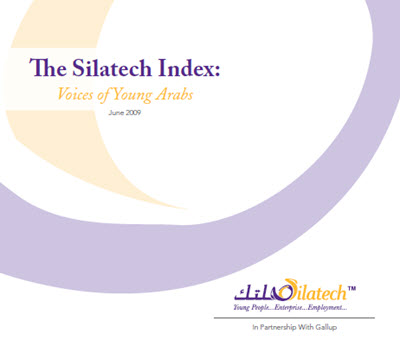-
‘Saving’ Themselves: How Innovative Financial Products Can Help Arab Youth Improve Their Lives
Sep 09, 2013Justin Sykes explains why financial literacy and youth savings are important but often overlooked tools in the struggle for economic development. It’s common wisdom by now: Political upheaval is upending the Arab world’s social and economic order. And just as much of this change is being propelled by youth, it is also affecting them in ways that demand creative—and urgent—solutions. But with many of the region’s governments struggling with persistent instability and even violence, top-down solutions would be years off and, even then, insufficient. That’s why local institutions, both public and private, are acting now—partnering with international donor agencies to help youth access the tools they need to improve their own lives. One such tool is as simple as it is scarce—the ability to save. Consider this: worldwide, more than one in three young people between the ages of 15 and 24 have a formal bank account. That’s including Sub-Saharan Africa, where many rural areas are beyond the reach of bank branches. Lagging behind every other region is the Arab World, where nearly nine out of 10 young people lack a formal account. What’s more, only two percent of Arab youth have ever saved money at a formal financial institution. These numbers matter. Saving money—however “micro” the amounts—provides youth an entry point into the formal financial sector, reducing their vulnerability to economic shocks, helping smooth out irregularities in income, and creating collateral for financial institutions to provide them with small business and other loans. Obstacles So why are savings rates among youth so low in the Arab world? For one thing, legislation in many countries has restricted the availability of savings services to a limited number of institutions—mostly commercial and public banks and state-run postal corporations. As important, the financial sector in the region has typically focused on a limited elite segment of the market and therefore has been slow to develop mass banking products. The good news is that, through a combination of political pressure, government and donor incentives, and new legislation, this status quo is beginning to change. Emerging Business Case Outreach to underserved youth is expanding in large part because banks are beginning to see a huge, untapped market opportunity. In Yemen and Morocco, for example, the micro-savings sector—such as it is—is dominated by youth, especially those newly entering the labor market. This stands to reason, of course: the so-called “youth bulge” in the Arab world is an obvious target of service providers across industries. The financial services industry is no exception, as banks in Yemen, Morocco, Egypt, and beyond are beginning to jockey for market share among youth and even use savings products as a way to cross-market other services—like micro-, small-, and medium-sized enterprise loans. Promising First Steps Taking advantage of this invigorated interest and modeled in part on other youth savings initiatives, such as the United Nations Capital Development Fund YouthStart program and the MasterCard Foundation-funded YouthSave initiative, Silatech—in partnership with the German development agency GIZ and Sanabel, the microfinance network for Arab countries—is spearheading a Regional Youth Savings Initiative for low-income Arab youth between the ages of 16 and 30. The idea grew out of a 2010 youth micro-savings pilot program with Al Amal Microfinance Bank in Yemen. In three years, that program has enabled more than 11,000 youth to open savings accounts for the first time, accumulating an active savings balance of US$ 276,734. In other words, this small pilot—in a country marked by dogged poverty and instability—has demonstrated what even the most altruistic observers had doubted: that youth savers are a viable business proposition. And formal financial institutions throughout the region are taking notice. In fact, the Silatech initiative is now expanding to Egypt and Morocco, where the National Bank of Egypt and Al Barid Bank, respectively, are developing new lending products designed to “graduate” youth savers into responsible borrowers who can avail themselves of affordable enterprise loans. Here’s how it works: the financial institutions offer a Youth Savings Account with a low minimum balance—Al Barid’s minimum, for example, is just US$ 6—and a mandatory “lock-in period,” which encourages clients to participate long enough to develop a credit history. With that history, they can obtain a debit card (which doubles as a discount card) and enter to win grant prizes with each subsequent savings milestone. In Yemen, for example, one milestone qualifies a youth savings client for US$ 7,000 in project start-up money. Building Financial Literacy To sustain this momentum and encourage more youth to participate—especially from poorer, more marginalized communities—Youth Savings Accounts will be offered through specially designed counters by staff trained to build their clients’ financial literacy. The approach is rigorous. Each client opening an account will receive a compulsory orientation by customer service staff or credit officers, who will cover key topics like understanding interest and debt management. Part of the aim is to cross-market further financial literacy resources. In Morocco, for instance, these resources include a customized curriculum offered by Centre Mohammed VI de Soutien à la Microfinance Solidaire, or CMS. Educating individual clients is not enough, though. The Silatech program aims to build a culture of savings and financial responsibility among all Arab youth. That’s why the program is developing multimedia campaigns that use social media platforms to inform youth about new products that are available to them in the market and, crucially, how tey can help improve their lives. Next Steps The Silatech savings initiative is expected to reach approximately 150,000 youth in Egypt, Morocco, and Yemen with micro-savings and financial literacy training. But this is not a program for its own sake. Silatech and its partners will take a close look at what works—and what doesn’t—after the program’s second year. If what we’ve learned so far continues to be true and the program attracts ever-larger numbers of youth savers, it’s a good bet we’ll be seeing Youth Savings Accounts in more countries throughout the region. About Silatech Silatech promotes large-scale job creation, entrepreneurship, access to capital and markets, and the participation and engagement of young people in economic and social development. To date, Silatech has provided support to youth-specific financial and non-financial support programs, which impacted over 500,000 young people –including supporting the start-up or growth of more than 30,000 youth run enterprises in the Arab World. This article was originally published by Youth Economic Opportunities.Read More -
A New Platform Of Hope For Arab Youth
Mar 30, 2012In this opinion piece, the authors argue for innovative uses of technology and new forms of social giving to catalyze the MENA region’s philanthropic potential. The Arab world today is home to millions of young people with hopes, plans and the desire to work. With more than 100 million young people between 15 and 29, representing 30 per cent of the total population, the region is facing an unprecedented ―youth bulge. This reality has led to many challenges when it comes to youth employment – but it can also be seen as an opportunity to foster youth-powered positive change, using social networks and technology to create much-needed impact. Today, there simply aren’t enough jobs for youth coming into the region’s labour markets. Public sector jobs are no longer a guarantee for graduates, and the private sector is unable to grow fast enough. For example, in Egypt 600,000 young people enter the labour market each year, but only about 250,000 of them find a job. The result: millions of young adults are forced to make a living on their own through self-employment, despite low incomes. For many of these micro-entrepreneurs – who have very small, self-owned enterprises – the only thing standing between subsistence level income and thriving, sustainable businesses is a lack of reliable, affordable capital. But too many financial institutions see young people as a risk when it comes to loaning money. It may be time for others to help fill the gap. Even though young Arabs may still be looking for work, they definitely have found their voice. The advent of technologies such as the Internet, mobile phones and social media has provided young people with tools to help them make change happen. One way to drive change is to fund, engage and celebrate young people who are trying to make a living on their own, and show how we as individuals around the world can help foster change. Technology and social media play an important role in achieving this. Accordingly, two organizations—Silatech, the Arab region’s largest youth microenterprise support provider, and Kiva, the world’s largest online microlending platform—have together created Kiva Arab Youth, an online platform that offers a way for people throughout the world to help young Arab entrepreneurs start or grow their businesses through small microloans of as little as $25. An example of how this works in practice is Shawgy, a 26-year-old man who lives in Taiz, Yemen. He couldn't afford an education and decided to start his own shop, which he has run for four years to help support his family. He wants to increase his sales to offer his parents a better future – but in order to do so needs to buy more products that offer his customers more variety. He lacks the capital to do this on his own, but a small loan will allow him to buy more products and increase his sales. Kiva lenders – ordinary people around the world – can make small contributions towards loans for individuals like Shawgy in the Arab world through Kiva’s online platform, which are matched by Silatech. But this is only the start. There is a clear opportunity for the creation of online peer-to-peer platforms in Arabic that connect charities, lenders and donors (in Arab countries and globally) — potentially including Islamic charitable giving— to self-employed young men and women from disadvantaged backgrounds. There is a growing movement in the Arab and Muslim worlds toward more strategic, capacity-building forms of charitable giving which focus on long-term, sustainable impact. Sustainable giving models such as ―revolving loan funds‖(which are loaned, repaid and returned to the lender to be reinvested to help more people), or ―social investments‖(which direct investor attention towards projects which generate social, as opposed to purely financial, returns), provide an opportunity to use these technology platforms to enable more impactful giving. These can be created for the young, and potentially by the young as well. If widely adopted by the Arab world, such technology initiatives could mobilise billions of dollars by re-focusing current streams of charitable giving. Forums like the World Congress of Muslim Philanthropists (WCMP), a global network of individuals, foundations and corporations advancing charitable giving, offer a significant opportunity to showcase potential solutions that increase engagement between donors and recipients and fund projects that have positive social impacts. Organizations such as Silatech – through its stakeholders, sponsors and partners in Qatar and elsewhere in the Arab region – have an opportunity to spark such a discussion and influence strategies and mind-sets about innovative uses of technology, as well as new forms of social giving. Opinion shapers, social entrepreneurs, religious figures and other influencers in the region should consider putting their support behind this and similar forms of sustainable social action. Ramakant Vempati is Senior Advisor and Justin Sykes is Manager for Social Innovation at Silatech. This article was written for the Common Ground News Service (CGNews), www.commongroundnews.org.Read More -
Silatech Index Brief: 2011
Dec 30, 2011Conducted with Gallup, this Silatech Index Brief focuses on three key elements needed to unlock opportunities for young people in the Arab world: Access, Policy, and Mindset. In 2009, Silatech and Gallup introduced a Silatech Index as a way to benchmark levels of economic opportunity and inclusion among Arab Youth and track changes over time. Index scores for 2012 include results from 19 Arab countries and the Somaliland region of Somalia. In many countries, index scores have changed, either moving up or down, underscoring the dynamic nature of the index dimensions and the effects of evolving economic, societal, and political events in the region. As the perceptions of young Arabs grow more positive or negative over time, the Silatech Index measures progress on the ground. This report also provides an analysis of the factors that are most predictive of a higher Silatech index in each measured country. The index focuses on three key elements needed to unlock opportunities for young people in the Arab world: Access, Policy, and Mindset. Access examines young people’s access to demand-driven and market-oriented skills training and job placement services and to improve micro-, small-, and medium-sized enterprises’ (MSMEs) access to capital, business development services, and markets. For young people to succeed in finding gainful employment, they need access to skills training, job counseling, and placement services linked to market requirements. Research shows, however, that given the regional youth bulge, there will not be enough jobs to employ those young people entering the labor market even if they have the type of skills employers desire. This fact drives the need to focus on addressing the needs of young entrepreneurs to access financial products and services, business development services, and links to corporate supply chains and national, regional, and global markets. The provision of such support serves to enable their growth and expansion such that they become the engine of local economic growth and job creation. Policy examines the adoption of enabling policies to stimulate increased employment and economic opportunities for young people and social inclusion. Leaders must shape government policies to improve the competitiveness of the labor market, the strength of the business environment, and the overall employment and economic opportunities for young people. Mindset examines society’s recognition of and support for young people’s contributions to economic and social capital and youth’s understanding of the realities of working life. Research shows that many factors help or hinder young people’s pathways to employment and social inclusion. It is important to build on traditional values to improve attitudes toward various types of work, gender norms, and family and community support that accelerate young people’s meaningful engagement in society and the economy.Read More -
The Silatech Index: Voices Of Young Arabs
Nov 30, 2010This is the third edition of The Silatech Index: Voices of Young Arabs report series. The study is a multi-year research initiative undertaken by Gallup in partnership with Silatech to shed light on young Arabs’ attitudes toward employment and entrepreneurship in their countries. This research endeavor is designed to provide a quantitative-based approach to inform policies and initiatives of job creation across the Middle East and North Africa region (MENA). This new report presents the 2010 Silatech Index scores for 19 Arab League countries and the Somaliland region of Somalia. Index scores for many countries have changed, moving either up or down, since previous editions, underscoring the dynamic nature of the Silatech Index dimensions. Such movement further points to the importance of tracking young Arabs’ perceptions over time to measure progress on the ground.Read More -
Social Entrepreneurship In The Middle East: Toward Sustainable Development For The Next Generation
Apr 30, 2010This joint report—published by Silatech, the Middle East Youth Initiative, the Wolfensohn Center for Development, and the Dubai School of Government—lays a foundation for a better understanding of the importance of social entrepreneurship in the Middle East. Despite the promise of an increasingly educated population of young people, the Middle East’s “youth bulge” generates pressure on education systems, labor markets, health care, natural resources and infrastructure. In this context, and with constrained public and private resources, traditional development frameworks in the Middle East are proving inadequate and are in need of transformation. Within the complex ecosystem of domestic governments, international donors, private businesses and individual philanthropists, the emerging model of social entrepreneurship offers potential as being one model to address the multi-sectoral challenges young people face in the Middle East. This report draws on existing literature to focus on four central principles of social entrepreneurship: Achievement of positive social impact: Social entrepreneurship responds to communities that have been marginalized or excluded by existing market actors and non-market institutions; Non-conventional thinking: Social entrepreneurship aims for what Joseph Schumpeter called “creative destruction,” a revolutionary transformation of a pattern of production which is often associated with entrepreneurship at large but, in the case of social entrepreneurship, is applied to social challenges; Use of sustainable methods: Social entrepreneurship must include a strategy for achieving financial sustainability, such as earning income; and, Innovation that can be adapted and “scaled up” beyond the local context: It is by pioneering ideas that can be applied at a larger scale that social entrepreneurship is able to contribute to systemic and path-breaking change. Social entrepreneurship often requires more than one individual to achieve impact and, often, a dedicated organization through which to carry out its work. The social enterprise is an organization with a clear social mission and a strategy that combines resourcefulness and innovation, which allow it to be financially sustainable. Social enterprises can assume a variety of legal and organizational models, but generally can be divided into four categories: Leveraged nonprofits capitalize on the interest of a variety of stakeholders to operate and to secure ongoing support based on a diversified portfolio of funding. Enterprising nonprofits have a self-financing component contributing to the organization’s sustainability. Hybrid enterprises combine aspects of the for-profit and nonprofit legal models, either through an innovative legal structure or by using a for-profit subsidiary to support the social activities of the nonprofit. Social businesses are those that can demonstrate market-level financial performance and competitiveness while expressing an equal or greater commitment to a social aim. Several trends in the region point to the important role that social entrepreneurship can play in capitalizing on the youth bulge, including an increased sense of social commitment expressed by a growing youth population, the incremental yet increasing ease of doing business in many of the countries, and the growing strategic orientation that is being adopted by the region’s philanthropic donors. Together, these represent promising trends for social entrepreneurs seeking talent and capital to start their own enterprises. Yet only with a conducive institutional environment can social entrepreneurship grow into a transformative tool in the field of youth economic development.Read More -
The Silatech Index: Voices Of Young Arabs
Jan 31, 2010The Silatech Index: Voices of Young Arabs is Silatech’s and Gallup’s second report on young people’s perceptions about job creation and the business environment in their respective countries. Gallup and Silatech undertook this study to provide a much-needed resource for Silatech and the Silatech Knowledge Consortium, and to support the efforts of leaders, experts, and policy-makers across the Middle East and North Africa as they address one of the region’s biggest challenges. Between July and October 2009, Gallup polled more than 18,000 nationals across 20 countries that are members of the League of Arab States and the Somaliland region of Somalia. Of those polled, more than 8,000 are nationals aged 15 to 29. Gallup conducted the previous wave of Silatech index data collection between February and April 2009 (with a total sample of more than 18,000 national respondents, including more than 8,000 youth aged 15 to 29). ¬The survey is conducted twice per year. The first report, which covered research in 19 countries and Somaliland, was published in June 2009.Read More -
The Silatech Index: Voices Of Young Arabs
Jun 30, 2009This report, The Silatech Index: Voices of Young Arabs, a Silatech study prepared in partnership with Gallup, measures and analyzes attitudes of almost 20,000 young Arabs with respect to their hopes and desires in life, human capital, work, entrepreneurship, and obstacles to success. Findings from the report underscore the importance of looking at young people as today’s vital partners with a stake in their societies, rather than viewing them as tomorrow’s beneficiaries for whom employment must be found. The report attempts to capture the voices of young people across the Arab world. Between February and April 2009, Gallup interviewed 8,597 national youth (aged 15 to 29) across 19 countries that are members of the Arab League and the Somaliland autonomous region. In addition, 9,590 nationals aged 30 and older were also polled during the same period. The survey will be repeated two times per year to gauge young people’s views over time. Through public opinion research, the report provides action-driven findings about the perceptions and views of young Arabs that can help national governments and policy-makers develop and implement comprehensive initiatives to create environments for the full utilization of human capital among youth. Drawing from its deep experience in survey research, Gallup designed the Silatech Index Model (SIM), which relies on four main constructs of Mindset, Policy, Access, and Decent Work.Read More

